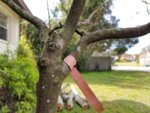SU2
Omono
Hi everyone!! So this is my first year where, in winter, I've got full-sized trees that are just being kept alive til spring when I can safely work them into stock/pre-bonsai's, and while most seem straight-forward enough there is one I'm very split on - in fact 'splitting it' is even crossing my mind!
So I got this Kumquat recently, sitting in his large container w/ organic soil and sporting foliage & 2 fruits (green ones, not the orange I see online..)

My original thinking was "trunk is thin but I can probably work with that" and that to do so I'd simply wait til real growth resumes (~March) and start doing hard-prunes, cutting everything back to the lowest-active-node, then waiting for back-budding beneath those....then cut-back to the new back-budding, until I'm finally at the point where I'm getting buds on the beginnings of the 3 limbs/sub-trunks (where the single trunk splits to 3) and then use those 3 as the 'primaries' with my newly-formed buds/shoots as secondaries from those; this would likely require 2-4 hard-prunes, depending how readily it back-buds (not too readily, from how I understand fruit trees in-general), so basically spending the first season just setting the first primaries (or secondaries I guess) But, with a trunk that tall&straight, I don't think this will make a bonsai but a topiary/niwaki instead and that's not the goal (hmm, perhaps it would be if I had other kumquats, but not for my only one!)
I've started thinking it's the wrong move, and that instead I should just air-layer the thing!!! So, what do you guys think should I be air-layering that '3 sub-trunk split' from the rest of the trunk, giving me a 3-trunked base once I remove the layering from the trunk?

I feel like, if that is the best approach (air-layering that top off), that I may be able to do so in a way wherein I get a "2-for-1", IE what if, instead of only air-layering that top off, what if I simultaneously air-layer *and* do the aforementioned hard-prunes? Wouldn't that give me a chance of not only capturing that top (w/ the base of the new / layered specimen being that quasi-whorl where it splits to 3) *but* also letting me keep the trunk that's there now IE the air-layering isn't removed until I've gotten budding below it, so its removal /= death for the stick/roots that comprise the bottom-half of this specimen!
Thanks a ton for any&all advice on this one, am pretty sure that air-layering the top off it is the only way to get a decent bonsai going although the idea of also getting/keeping the trunk alive is real appealing, I know that part will take longer to develop but still Kumquats aren't a common one I come by so if I can get two I'd prefer that, although the most-important thing is to simply get good material even if it's just 1 piece from this
Again thanks and have a great weekend everyone!!!
So I got this Kumquat recently, sitting in his large container w/ organic soil and sporting foliage & 2 fruits (green ones, not the orange I see online..)

My original thinking was "trunk is thin but I can probably work with that" and that to do so I'd simply wait til real growth resumes (~March) and start doing hard-prunes, cutting everything back to the lowest-active-node, then waiting for back-budding beneath those....then cut-back to the new back-budding, until I'm finally at the point where I'm getting buds on the beginnings of the 3 limbs/sub-trunks (where the single trunk splits to 3) and then use those 3 as the 'primaries' with my newly-formed buds/shoots as secondaries from those; this would likely require 2-4 hard-prunes, depending how readily it back-buds (not too readily, from how I understand fruit trees in-general), so basically spending the first season just setting the first primaries (or secondaries I guess) But, with a trunk that tall&straight, I don't think this will make a bonsai but a topiary/niwaki instead and that's not the goal (hmm, perhaps it would be if I had other kumquats, but not for my only one!)
I've started thinking it's the wrong move, and that instead I should just air-layer the thing!!! So, what do you guys think should I be air-layering that '3 sub-trunk split' from the rest of the trunk, giving me a 3-trunked base once I remove the layering from the trunk?

I feel like, if that is the best approach (air-layering that top off), that I may be able to do so in a way wherein I get a "2-for-1", IE what if, instead of only air-layering that top off, what if I simultaneously air-layer *and* do the aforementioned hard-prunes? Wouldn't that give me a chance of not only capturing that top (w/ the base of the new / layered specimen being that quasi-whorl where it splits to 3) *but* also letting me keep the trunk that's there now IE the air-layering isn't removed until I've gotten budding below it, so its removal /= death for the stick/roots that comprise the bottom-half of this specimen!
Thanks a ton for any&all advice on this one, am pretty sure that air-layering the top off it is the only way to get a decent bonsai going although the idea of also getting/keeping the trunk alive is real appealing, I know that part will take longer to develop but still Kumquats aren't a common one I come by so if I can get two I'd prefer that, although the most-important thing is to simply get good material even if it's just 1 piece from this
Again thanks and have a great weekend everyone!!!
